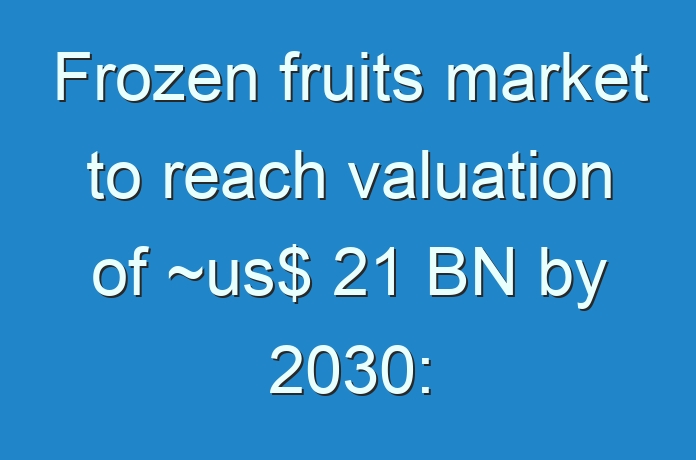
Frozen Fruits Market: Introduction
A recent study published by Transparency Market Research on the frozen fruits market comprises global industry analysis and opportunity assessment for 2020-2030. Revenue generated from the global frozen fruits market was valued at ~US$ 11 Bn in 2020, which is estimated to rise at a CAGR of 5.6%, to reach ~US$ 21 Bn by 2030. The rising demand for seasonal fruits and consumer awareness about clean label products with a longer shelf life is expected to support the growth of the frozen fruits market.
Request a Sample-
https://www.transparencymarketresearch.com/sample/sample.php?flag=S&rep_id=77619
Frozen Fruits Gain Traction in Global Market
According to the World Bank, over 60% of the world population lives in urban areas. Rise in the hectic lifestyle and slummy health conditions, owing to unhealthy eating habits is driving consumers to demand for special dietary needs and high nutrition products. Consumers are switching to healthy snacking due to convenience and nutrition offered by such products, as round-the-clock snacking is the new “normal”. Healthy snacking also helps in keeping blood sugar levels in check throughout the day, helping to avoid the infamous nap-inducing slumps in between meals, losing weight, and boosts immune system. Frozen fruits are widely being used as and in snacks. Frozen fruits-based snacks are available in different fruit options and packaging to grab consumer attention. Moreover, vacuum frying and freeze drying methods are gaining momentum in the frozen fruits market, as companies are adopting these technologies in the snack industry to retain original flavor, original shape of the product, and provide maximum nutrition.
Freezing Technique such as IQF a Cost-effective Process to Preserve Fruits
Freezing technique offer cost advantage over other processing methods, such as canning and drying where certain raw materials (sugar, preservatives, etc.) are required in addition to fresh fruits, which adds on the cost of processing. Furthermore, the IQF freezing technology is much faster than the cold freezing technology. The shorter processing time translates into less electricity consumption and thus, to cost-saving and energy conserving. The process also involves simple packaging requirements for processed fruits as compared to more complex and costlier packaging involved in methods such as canning. The lesser production cost is leading to the growing demand for the IQF freezing technology, thereby, providing boost to the frozen fruits market. In addition, during transportation or in heat and light exposure, frozen fruits have the properties to protect against spoilage.
Request for covid19 impact analysis –
https://www.transparencymarketresearch.com/sample/sample.php?flag=covid19&rep_id=77619
Manufacturers Strive to Innovate
An increasing number of the global working population is creating a new requirement for convenience foods due to time constraints. Frozen fruits also offer ease of use, storage, and further processing. Consumers are trying different tastes and flavors and offering for fruit flavors in their products, especially in bakery and confectioneries. This is driving the demand for various seasonal fruits in end-use industries such as bakery, confectioneries, smoothies, RTD beverages, and others.
E-Commerce to Fuel Frozen Fruits Market Growth Prospects
Consumers can now shop frozen products online, including imported fruits that are not grown or sold locally. The growth of online retailing has resulted in a widespread supply of frozen fruits through cold storage and large network leading to easy availability and accessibility of frozen fruits to consumers.
Impact of COVID-19: Frozen Fruits Market
The global pandemic of Covid-19 has a deep impact on the frozen fruit industry, as coronavirus crisis hammers economies. Lockdowns and other stringent measures taken by governments have drastically changed the market for frozen fruits. The lockdown imposed to limit COVID-19 spread has also adversely weakened many players’ networks (supply chain). The uncertainty caused by the outbreak of COVID-19 has interrupted the import and export of frozen fruits due to the closing of international borders.
Global Frozen Fruits Market Segmentation
Frozen Fruits Market by Nature
- Organic
- Conventional
Frozen Fruits Market by From
- Diced
- Whole
- Sliced
Buy now-
https://www.transparencymarketresearch.com/checkout.php?rep_id=77619<ype=S
Frozen Fruits Market by Fruit Type
- Raisins
- Apples
- Apricots
- Peaches
- Mangoes
- Papaya
- Strawberry
- Raspberry
- Blueberry
- Cranberry
- Cherry
- Others
Frozen Fruits Market by End Use
- Food Processing Industry
- Breakfast Cereals
- Bakery Products
- Confectioneries
- Dairy & Frozen Dessert Products
- Ice creams
- Yogurt
- Others
- Snacks
- Salads
- Beverages
- Food Service Providers
- Retail/Household
Frozen Fruits Market by Distribution Channel
- B2B
- B2C
- Stored-based Retailing
- Supermarkets/Hypermarkets
- Convenience Stores
- Specialty Stores
- Food & Drink Specialty Stores
- Others
- Online Retail
- Stored-based Retailing
Frozen Fruits Market by Region
- North America
- S.
- Canada
- Latin America
- Brazil
- Mexico
- Chile
- Peru
- Argentina
- Rest of LATAM
- Europe
- Germany
- K.
- France
- Italy
- Spain
- Nordic
- Russia
- Poland
- Benelux
- Rest of Europe
- Asia Pacific Excl. Japan
- India
- China
- ASEAN
- South Korea
- Japan
- Middle East & Africa
- GCC Countries
- South Africa
- Turkey
- Iran
- Israel
- Rest of MEA
- Oceania
- Australia
- New Zealand
The world has undergone a major shift in the way of living since the COVID-19 pandemic struck. A notable change in the functioning of various businesses and sectors has influenced their working mechanisms extensively. The food and beverage sector is no stranger to this change. Transparency Market Research (TMR) has studied many aspects concerning the difference between the trends in the pre-pandemic and post-pandemic world across the food and beverage industry.
More Trending Report-





